Fernando de Magellan
ref. # 045c Unknown territories - Magellan's Map of Venus
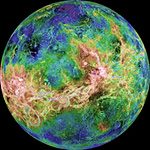 The Magellan spacecraft imaged more than 98% of Venus at a resolution of about 100 meters; the effective resolution of these images is about 3 kilometers. A mosaic of the Magellan images (most with illumination from the west) forms the image base. Gaps in the Magellan coverage were filled with images from Soviet Venera 15 and 16 spacecraft in the northern quarter of the planet, with images from the Earth-based Arecibo radar in a region centered roughly on 0 degrees latitude and 0 degrees longitude, and with a neutral tone elsewhere (primarily near the south pole).
The Magellan spacecraft imaged more than 98% of Venus at a resolution of about 100 meters; the effective resolution of these images is about 3 kilometers. A mosaic of the Magellan images (most with illumination from the west) forms the image base. Gaps in the Magellan coverage were filled with images from Soviet Venera 15 and 16 spacecraft in the northern quarter of the planet, with images from the Earth-based Arecibo radar in a region centered roughly on 0 degrees latitude and 0 degrees longitude, and with a neutral tone elsewhere (primarily near the south pole).The composite image was processed to improve contrast and to emphasize small features and was color-coded to represent elevation. Gaps in the elevation data from the Magellan radar altimeter were filled with altimetry from the Venera spacecraft and the U.S. Pioneer Venus missions.
©:
tags:
045d Unknown territories -Sebastian Munster, 1590, North & South America
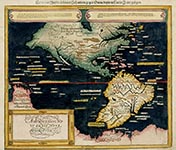 Sebastian Munster, 1590, North & South America
Sebastian Munster, 1590, North & South America©: Public Domain
tags: #Sebastian Munster
ref. # 046 Fernando de Magellan -portrait of Fernando de Magallanes
 "Fernando de Magallanes, c. 1480 - 27 April 1521, was a Portuguese explorer who organised the Spanish expedition to the East Indies from 1519 to 1522, resulting in the first circumnavigation of the Earth."
"Fernando de Magallanes, c. 1480 - 27 April 1521, was a Portuguese explorer who organised the Spanish expedition to the East Indies from 1519 to 1522, resulting in the first circumnavigation of the Earth."Wikipedia
"Born into a wealthy Portuguese family in around 1480, Magellan became a skilled sailor and naval officer and was eventually selected by King Charles I of Spain to search for a westward route to the Maluku Islands (the "Spice Islands"). Commanding a fleet of five vessels, he headed south through the Atlantic Ocean to Patagonia, passing through the Strait of Magellan into a body of water he named the "peaceful sea" (the modern Pacific Ocean). Despite a series of storms and mutinies, the expedition reached the Spice Islands in 1521 and returned home via the Indian Ocean to complete the first circuit of the globe. Magellan did not complete the entire voyage, as he was killed during the Battle of Mactan in the Philippines in 1521.
The Magellanic penguin is named after him, as he was the first European to note it. Magellan's navigational skills have also been acknowledged in the naming of objects associated with the stars, including the Magellanic Clouds, now known to be two nearby dwarf galaxies; the twin lunar craters of Magelhaens and Magelhaens A; and the Martian crater of Magelhaens." Wikipedia
©: photo: Edward Carlile
tags: #Fernando de Magellanes
ref. # 045 Pacific Ocean -Unknown territories
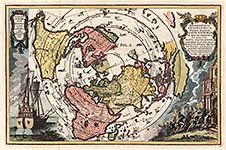 Unknown territories or expanding areas of knowledge
Unknown territories or expanding areas of knowledge"Scherer, Heinrich, 1628-1704. "Repræsentatio geographica itineris maritimi navis Victoriæ in qua ex personis CCXXXVII finita navigatione rediere tantum XVIII quæ solo indusio tectæ et faces accensas manibus præferentes in basilica hispalensi se voto exsolverunt VII Sept. ann. MDXXII" (ca. 1700). Copperplate map, with added color, 23 cm. in diam., on sheet 23 x 36 cm. From Scherer´s Atlas novus (Munich, 1702-1710). Reference: Shirley, Mapping of the World, 626. [Historic Maps Collection]"
"A devout Jesuit, Scherer´s maps usually contain religious overtones. Here, in its north polar projection of the world, Magellan´s circumnavigation is tracked and dated. The myth of California as an island continues. On the left is an engraving of Victoria, the only remaining ship from Magellan´s armada. On the right, the few survivors of the voyage are shown making their way to the Santa María de la Victoria church in Seville, where they go to give thanks for their safe return. The date, from the cartouche above the scene, is September 7, 1522; the number of men is 18 out of the original 237."
©: libweb5.princeton.edu
After the death of Ferdinand Magellan, the crew decided to persevere and find a route back home from the Philippines, around the Cape of Good Hope, to Spain. Credit for the successful circumnavigation of the globe should also go to the Basque mariner Juan Sebastian Elcano, who commanded the return voyage of Victoria - the only surviving vessel - from late 1521 until its arrival in Spain in September 1522.
tags: #Ferdinand Magellan #Sebastian Elcano
Ferdinand Magellan Biography:
Explorer (c. 1480 - 1521) While in the service of Spain, the Portuguese explorer Ferdinand Magellan led the first European voyage of discovery to circumnavigate the globe.
http://www.biography.com/people/ferdinand-magellan-9395202
045a Unknown territories -Magellan´s probe
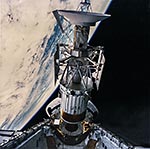 Unknown territories or expanding areas of knowledge
Unknown territories or expanding areas of knowledgeLaunched from the space shuttle Atlantis, Magellan journeyed to Venus, entering an orbit that took it over the planet's poles. As Venus rotated, Magellan's radar penetrated the thick cl, d that hides the surface. Magellan mapped Venus's surface in long, thin strips that covered 98% of the planet´s surface.
NASA mission scientists discovered that Venus is covered with volcanoes and strange landforms unlike any on the Earth. The probe saw few impact craters, suggesting Venus has a relatively young surface.
More on BBC
The Magellan spacecraft was launched 4 May 1989, and arrived at Venus on 10 August 1990.
©: Photo: View of Venus composed almost entirely of Magellan radar images (NASA/JPL/USGS)
tags: #Magellan probe #NASA
045b Unknown territories -Ferdinand Magellan´s death
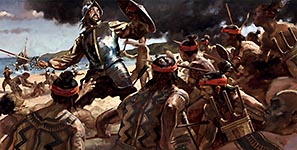 First around the world: MAGELLAN and Del Cano (DELCANO).
First around the world: MAGELLAN and Del Cano (DELCANO)."In 1519 Ferdinand Magellan led a Spanish expedition of 5 ships and 260 men in search of a westerly route to Asia. They experienced ice, storms, desertion, ship wreck, starvation and scurvy. Magellan was killed in a battle. In 1522 the leaking Victoria commanded by Del Cano creacked painfully back to Spain with 18 half-dead survivors."
"First world circumnavigator"
The Portuguese sailor Ferdinand Magellan is credited as being the first man to sail around the world. He was appointed commander of a fleet of five ships by king Carlos V of Spain at the beginning of the 16th. century. The aim was to find a way round the south tip of America to establish a new route to the Spice Islands. They departed from Sanlucar on 20th of September, 1519. He discovered the strait which has been given his name, and reached the Pacific Ocean on 28th of November, 1520. With the remaining three vessels of his fleet, he reached Cebu,in the heart of the Philippines the 7th of April, 1521. Magellan, the first European to reach these islands, was killed in a clash with natives on the neighboring island of Mactan, April 27, 1521. Even though he did not complete the voyage, it was Magellan's perseverance and leadership that made the first circumnavigation possible.
Elcano:
The actual title of 'First to circumnavigate the World' belongs to Juan Sebastian de ELCANO, one of Magellan's captains, who succeeded in bringing "Victoria", the only surviving vessel of the original fleet, back to the Spanish port Sanlucar de Barrameda on the 6th of December, 1522.Of the 239 men that left Seville in five ships only 17 returned. Most had perished from starvation and scurvy. Others died in accidents and clashes with natives. Some died in Portuguese prisons. We know the details of this extraordinary voyage from the complete log that was kept by an Italian crew-member, Antonio Lombardo Pigafetta. Portions of the translations of this log-book, as well as translations of other documents relating to this historic voyage, may be read here. The original manuscript in Italian is in the Ambrosian Library in Milan.
In the service of king Manuel of Portugal, Fernando Magellan (Fernão de Magalhães in Portuguese) had previously sailed round the Cape of Good Hope (the southern tip of Africa) as far east as Ambon and Banda in the Mollucan Islands, then called the Spice Islands, the rich source of nutmeg and cloves. These islands are further east than the Philippines, consequently it is correct to state that Magellan had sailed all around the world, because he had crossed all the meridians in two separate voyages.
He returned to Portugal in 1512 and fell out of favor with the Portuguese court. He then went to the Spanish court to obtain support to search for a westbound passage to the Spice Islands."
"Recognizing the captain, so many turned upon him that they knocked his helmet off his head twice.. an Indian hurled a bamboo spear into the captain's face, but the latter immediately killed him with his lance, which he left in the Indian's body. Then, trying to lay hand on sword, he could draw it out but halfway, because he had been wounded in the arm with a bamboo spear. When the natives saw that, they all rushed themselves upon him. One of them wounded him on the left leg with a large cutlass, which resembles a scimitar, only being larger. That caused the captain to fall face downward, when immediately they rushed upon him with iron and bamboo spears and with their cutlasses, until they killed our mirror, our light, our comfort, and our true guide. When they wounded him, he turned back many times to see whether we were all in the boats. Thereupon, beholding him dead, we, wounded, retreated, as best we could, to the boats, which were already pulling off.."
©: Wikipedia
tags: #Magellan; #de Elcano; #Delcano
ref. # 045c Unknown territories -Magellan's Map of Venus
 The Magellan spacecraft imaged more than 98% of Venus at a resolution of about 100 meters; the effective resolution of these images is about 3 kilometers. A mosaic of the Magellan images (most with illumination from the west) forms the image base. Gaps in the Magellan coverage were filled with images from Soviet Venera 15 and 16 spacecraft in the northern quarter of the planet, with images from the Earth-based Arecibo radar in a region centered roughly on 0 degrees latitude and 0 degrees longitude, and with a neutral tone elsewhere (primarily near the south pole).
The Magellan spacecraft imaged more than 98% of Venus at a resolution of about 100 meters; the effective resolution of these images is about 3 kilometers. A mosaic of the Magellan images (most with illumination from the west) forms the image base. Gaps in the Magellan coverage were filled with images from Soviet Venera 15 and 16 spacecraft in the northern quarter of the planet, with images from the Earth-based Arecibo radar in a region centered roughly on 0 degrees latitude and 0 degrees longitude, and with a neutral tone elsewhere (primarily near the south pole).The composite image was processed to improve contrast and to emphasize small features and was color-coded to represent elevation. Gaps in the elevation data from the Magellan radar altimeter were filled with altimetry from the Venera spacecraft and the U.S. Pioneer Venus missions.
©:
tags:
045d Unknown territories -Sebastian Munster, 1590, North & South America
 Sebastian Munster, 1590, North & South America
Sebastian Munster, 1590, North & South America©: Public Domain
tags: #Sebastian Munster
ref. # 046 Unknown territories -portrait of Fernando de Magallanes
 "Fernando de Magallanes, c. 1480 - 27 April 1521, was a Portuguese explorer who organised the Spanish expedition to the East Indies from 1519 to 1522, resulting in the first circumnavigation of the Earth."
"Fernando de Magallanes, c. 1480 - 27 April 1521, was a Portuguese explorer who organised the Spanish expedition to the East Indies from 1519 to 1522, resulting in the first circumnavigation of the Earth."Wikipedia
"Born into a wealthy Portuguese family in around 1480, Magellan became a skilled sailor and naval officer and was eventually selected by King Charles I of Spain to search for a westward route to the Maluku Islands (the "Spice Islands"). Commanding a fleet of five vessels, he headed south through the Atlantic Ocean to Patagonia, passing through the Strait of Magellan into a body of water he named the "peaceful sea" (the modern Pacific Ocean). Despite a series of storms and mutinies, the expedition reached the Spice Islands in 1521 and returned home via the Indian Ocean to complete the first circuit of the globe. Magellan did not complete the entire voyage, as he was killed during the Battle of Mactan in the Philippines in 1521.
The Magellanic penguin is named after him, as he was the first European to note it. Magellan's navigational skills have also been acknowledged in the naming of objects associated with the stars, including the Magellanic Clouds, now known to be two nearby dwarf galaxies; the twin lunar craters of Magelhaens and Magelhaens A; and the Martian crater of Magelhaens." Wikipedia
©: photo: Edward Carlile
tags: #Fernando de Magellanes
ref. # 115a - Willem Schouten de Hoorn
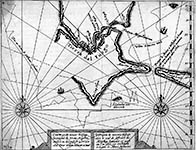 Description of the New Route to the South of the Strait of Magellan Discovered and Set in the Year 1616 by Dutchman Willem Schouten de Hoorn
Description of the New Route to the South of the Strait of Magellan Discovered and Set in the Year 1616 by Dutchman Willem Schouten de Hoorn"In June 1615, Dutch navigators Jacob Le MAIRE (circa 1585 - 1616) and Willem Corneliszoon SCHOUTEN (circa 1567 - 1625) set out in two ships, the 'Eendracht' and the 'Hoorn', from the Dutch port of Texel. Their goal was to find a new route to the Moluccas Islands, Europe's main source of pepper in the lucrative spice trade with the East Indies, and in so doing avoid the trade monopoly of the Dutch East Indies Company. They sailed south of the Strait of Magellan and on January 24, 1616, discovered a new passage between the Atlantic and Pacific oceans: a strait about 13 kilometers wide between Tierra del Fuego and what they called Staten Land (present-day Isla de los Estados, Argentina). The passage came to be called Le Maire Strait. Several days later, Le Maire and Schouten became the first Europeans to round the extreme southern point of South America, known for its storms and heavy seas, which they named Cape Horn in honor of Schouten's birthplace, the city of Hoorn. This map of Le Maire Strait is from the French edition of Schouten's journal of the voyage, Journal ou description du merveillevx voyage de Guillaume Schovten, hollandois natif de Hoorn, fait en ann&eeacute;es 1615, 1616 & 1617 (Journal or description of the marvelous voyage of Willem Schouten, a Dutch native of Hoorn, made in the years 1615, 1616, and 1617), which was published in Amsterdam in 1619".
©: World Digital Library
tags: #Strait; #Magellan; #Schouten; #le Maire Strait; #Hoorn
ref. # 116 - Death of Magellan
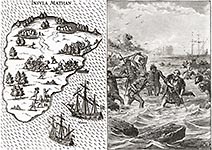 "Death of Magellan on the Philippine island of Mactan. From Levinus Hulsius's Sechster Theil, kurtze, warhafftige Relation vnnd Beschreibung der wunderbarsten vier Schiffahrten . . . (Frankfurt, 1626). [Rare Books Division]"
"Death of Magellan on the Philippine island of Mactan. From Levinus Hulsius's Sechster Theil, kurtze, warhafftige Relation vnnd Beschreibung der wunderbarsten vier Schiffahrten . . . (Frankfurt, 1626). [Rare Books Division]"libweb5.princeton.edu
"Recognizing the captain, so many turned upon him that they knocked his helmet off his head twice... an Indian hurled a bamboo spear into the captain's face, but the latter immediately killed him with his lance, which he left in the Indian's body. Then, trying to lay hand on sword, he could draw it out but halfway, because he had been wounded in the arm with a bamboo spear. When the natives saw that, they all rushed themselves upon him. One of them wounded him on the left leg with a large cutlass, which resembles a scimitar, only being larger. That caused the captain to fall face downward, when immediately they rushed upon him with iron and bamboo spears and with their cutlasses, until they killed our mirror, our light, our comfort, and our true guide. When they wounded him, he turned back many times to see whether we were all in the boats. Thereupon, beholding him dead, we, wounded, retreated, as best we could, to the boats, which were already pulling off..."
©: "The Death of Magellan, 1521," EyeWitness to History, www.eyewitnesstohistory.com (2001).
tags: #Magellan
